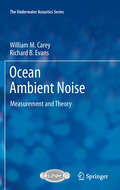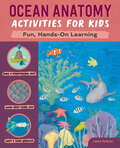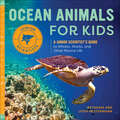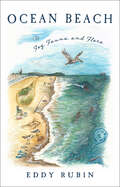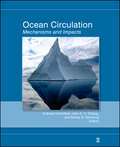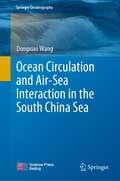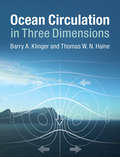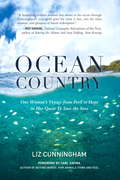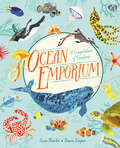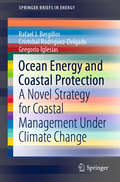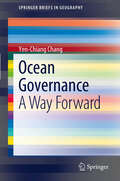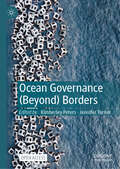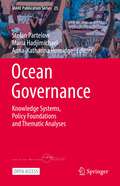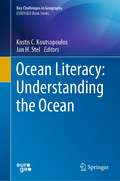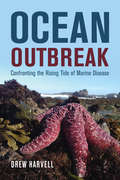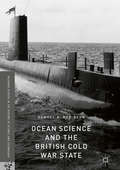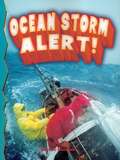- Table View
- List View
Ocean Ambient Noise
by Richard B. Evans William M. CareyThis monograph develops the theory of noise mechanisms and measurements, and describes general noise characteristics and computational methods. The vast ambient noise literature is concisely summarized using theory combined with key representative results. The air sea boundary interaction zone is described in terms of nondimensional variables requisite for future experiments. Noise field coherency, rare directional measurements, and unique basin scale computations and methods are presented. The use of satellite measurements in these basin scale models is demonstrated. A series of appendices provides in-depth mathematical treatments which will be of interest to graduate students and active researchers.
Ocean Anatomy Activities for Kids: Fun, Hands-On Learning (Anatomy Activities for Kids)
by Laura PetrusicExplore like a scientist with this illustrated ocean guide for kids ages 8 to 12 Dive into the big blue sea with Ocean Anatomy Activities for Kids! Travel around the world and down into the deep with illustrations and diagrams that show you how the different parts of the ocean work together. As you read about our amazing aquatic universe, you'll learn how to think like a marine scientist. Ocean Anatomy Activities for Kids goes beyond other marine biology books with: The world underwater—Discover 20 lessons that teach you about everything from kelp forests to coral reefs. Awesome activities—See ocean science in action with fun experiments like creating mini ocean currents and finding out what makes fish float. Your own ocean journal—Answer cool questions after each activity to figure out even more about what makes the ocean so special. Learn all about marine life as you journey the seas with this colorful kids' guide to ocean anatomy.
Ocean Animals and Their Ecosystems: A Nature Reference Book for Kids
by Erica ColónMeet marine animals and their ecosystems—a book of ocean exploration for kids 8 to 12The ocean covers 71 percent of the Earth's surface—and it's swimming with wild and beautiful marine animals. Packed with beautiful photos and interesting facts, this guide goes beyond other nature books for kids, taking you under the sea and into the homes of incredible ocean dwellers.This guide takes you into vibrant coral reefs, jagged coastlines, and icy polar regions. You'll explore how each ecosystem has changed, discover amazing ocean animals through exciting photos, and learn how a rich biodiversity contributes to a healthy ecosystem.This standout among nature books for kids includes:Packed with ocean animals—From powerful sharks to smart octopuses to fascinating deep sea creatures, swim with ocean animals and get to know them through fun facts, such as their diet, lifespan, and weight.Into the deep—Dive deeper than other nature books for kids with in-depth looks at the world's oceans, their ecosystems, and their habitats.Stunning photographs—Vivid, big, colorful photographs not found in other nature books for kids give you an up-close look at these wonderful marine animals and their environment.If you're looking for nature books for kids but aren't sure where to start, this guide will let you swim with and save our marine friends!
Ocean Animals for Kids: A Junior Scientist's Guide to Whales, Sharks, and Other Marine Life (Junior Scientists)
by Bethanie Hestermann Josh HestermannExplore the big world under the waves with the Junior Scientists series for kids ages 6 to 9 The oceans are full of creatures that are beautiful and strange. Whether you're a fan of sharks, snakes, penguins, or polar bears, Ocean Animals for Kids is full of fascinating critters to meet! Get ready to learn all about the mammals, birds, fish, reptiles, and invertebrates that call the ocean home.Dive deeper than other ocean books for kids with:Animal profiles—Take a look at dozens of marine species, from sea spiders to sponges, and find out where they live, what they eat, and more!An intro to marine science—This standout among ocean books for kids investigates currents, tides, climate, and what's hiding in the deepest, darkest parts of the ocean.Fun facts—Jump into the best in ocean books for kids and find out which sea-dwellers can open jars, who has pink poop, and what happens when marine iguanas sneeze!See what's happening underwater with this exciting entry into ocean books for kids.
Ocean Beach: Fog, Fauna, and Flora
by Eddy RubinA charmingly illustrated nature guide to Ocean Beach and the coastal ecology of San Francisco.Grab your beach blanket and your puffy jacket (this is San Francisco, after all) and get ready to see Ocean Beach like never before. Longtime local surfer and scientist Eddy Rubin celebrates this magical sandy stretch through stories of its animals and plants and the natural and human forces that have shaped this coastal environment. From sand dollars and seaweed to the snowy plovers in the dunes, and stretching out to the seals and whales offshore, Rubin profiles twenty-nine local flora and fauna with wonder and curiosity. To explain the why and how, he also teaches readers about the weather and geological forces that have created this unique sandy ecology. Lifetime lovers of Ocean Beach and new neighbors alike will delight in Rubin's guide, brought vividly to life by more than forty full-color artworks by illustrator Greg Wright. With this guide, Rubin invites readers to explore the place where ocean and land meet, to learn from surfers and fishermen about what's out in the waves, and to protect this shared expanse of sandy shoreline.
Ocean Circulation
by John C. Chiang Andreas Schmittner Sidney R. HemmingPublished by the American Geophysical Union as part of the Geophysical Monograph Series, Volume 173.The ocean's meridional overturning circulation (MOC) is a key factor in climate change. <P><P>The Atlantic MOC, in particular, is believed to play an active role in the regional and global climate variability. It is associated with the recent debate on rapid climate change, the Atlantic Multi-Decadal Oscillation (AMO), global warming, and Atlantic hurricanes.This is the first book to deal with all aspects of the ocean's large-scale meridional overturning circulation, and is a coherent presentation, from a mechanistic point of view, of our current understanding of paleo, present-day, and future variability and change. It presents the current state of the science by bringing together the world's leading experts in physical, chemical, and biological oceanography, marine geology, geochemistry, paleoceanography, and climate modeling. A mix of overview and research papers makes this volume suitable not only for experts in the field, but also for students and anyone interested in climate change and the oceans.
Ocean Circulation and Air-Sea Interaction in the South China Sea (Springer Oceanography)
by Dongxiao WangThis book summarizes achievements of the study on circulation and air–sea interaction and development of the ocean observation network in the South China Sea in the last 20 years, thus serving as a comprehensive reference book to understand the dynamic environment in the SCS. It consists of seven chapters, briefly reviewing our understanding of the SCS circulation and air–sea interaction in chapter 1, then describing in detail the upper layer circulation from large scale (SCS through flow, SCS western boundary current, etc.), to meso- and submeso-scale in Chapters 2 and 5, dilute river plume and coastal upwelling over the shelf in Chapter 3, deep ocean circulation in Chapter 4, tropical cyclone activities and air–sea flux at the interface in Chapter 6, and the construction of the observation network and database in Chapter 7. Besides the basic features of these physical processes, the book also discusses their variations and fundamental dynamics. Thus, it is written in a way that meets the different information demands from researchers working in various marine related fields.
Ocean Circulation in Three Dimensions
by Barry A. Klinger Thomas W. HaineNotable advances of the last quarter-century have deepened our appreciation of the three-dimensional nature of the ocean's large-scale circulation. This circulation has important implications for ocean chemistry and biology, atmospheric science, and climate. Ocean Circulation in Three Dimensions surveys both observations and theories of the time-mean circulation, enabling readers to see the relevance and limitations of leading theories, as well as the patterns linking the behavior of different oceans. The book covers “classical” topics of horizontal circulation, and expands them to include shallow wind-driven overturning, the deep global “conveyer belt”, high latitudes, the role of eddies, and the ocean's role in heat transport. Solutions to exercises are available online for instructor use. This textbook is ideal for students of physical oceanography, chemical oceanography and climate. It is also suitable for readers from related fields as it includes a summary of introductory topics.
Ocean Counting: Odd Numbers (Jerry Pallotta's Counting Books)
by Jerry PallottaWith his trademark humor and wit, Jerry Pallotta teaches young readers how to count to 50 by odd numbers, using weird and wonderful ocean animals as counting tools. Explore the ocean as you meet 13 surf clams, 29 mussels, 49 smelts, and more.
Ocean Country
by Carl Safina Liz CunninghamOcean Country is an adventure story, a call to action, and a poetic meditation on the state of the seas. But most importantly it is the story of finding true hope in the midst of one of the greatest crises to face humankind, the rapidly degrading state of our environment. After a near-drowning accident in which she was temporarily paralyzed, Liz Cunningham crisscrosses the globe in an effort to understand the threats to our dazzling but endangered oceans. This intimate account charts her thrilling journey through unexpected encounters with conservationists, fishermen, sea nomads, and scientists in the Mediterranean, Sulawesi, the Turks and Caicos Islands, and Papua, New Guinea.From the Trade Paperback edition.ansform despair into strength and to discover what true hope is.
Ocean Dynamics and the Carbon Cycle
by Richard G. Williams Michael J. FollowsThis textbook for advanced undergraduate and graduate students presents a multidisciplinary approach to understanding ocean circulation and how it drives and controls marine biogeochemistry and biological productivity at a global scale. Background chapters on ocean physics, chemistry and biology provide students with the tools to examine the range of large-scale physical and dynamic phenomena that control the ocean carbon cycle and its interaction with the atmosphere. Throughout the text observational data is integrated with basic physical theory to address cutting-edge research questions in ocean biogeochemistry. Simple theoretical models, data plots and schematic illustrations summarise key results and connect the physical theory to real observations. Advanced mathematics is provided in boxes and appendices where it can be drawn on to assist with the worked examples and homework exercises available online. Further reading lists for each chapter and a comprehensive glossary provide students and instructors with a complete learning package.
Ocean Emporium: A Compilation of Creatures
by Susie BrooksA treasure trove of extraordinary ocean animals.Beneath the ocean waves lies a web of life that ties together creatures great and small. Fan favorites like hermit crabs and great white sharks share space with mysterious bottom-dwellers like mimic octopuses and giant sea spiders in this gorgeous exploration of the sea. Dive in and encounter some of the earth's most remarkable animals in this gloriously illustrated compendium. A perfect gift for all nature lovers.
Ocean Energy and Coastal Protection: A Novel Strategy for Coastal Management Under Climate Change (SpringerBriefs in Energy)
by Rafael J. Bergillos Gregorio Iglesias Cristobal Rodriguez-DelgadoThis book presents the innovative concept of the dual function of wave farms as both renewable energy generators and coastal protection elements against erosion and flooding. Developing renewable energy is one of the most pressing targets for society in the coming decades due to the finite nature of fossil fuels, their high costs, and the environmental impacts of their exploration and use, including climate change and the subsequent sea-level rise. Wave energy is one of the most promising renewable energy sources, thanks to its huge potential and low impact on the environment. As such, this book discusses the development and application of artificial intelligence to optimise wave farm location and layout, assesses the influence of the wave energy converter geometry on coastal protection against erosion and flooding, and analyses how the performance of wave farms as coastal defence elements is affected by climate change and sea level rise. The concepts, methods and conclusions presented are helpful to students, researchers, academics, engineers, designers, stakeholders and managers around the globe interested in wave energy, coastal engineering, and coastal management.
Ocean Engineering Mechanics
by Michael E. MccormickOcean Engineering Mechanics is designed to give an introduction to water waves and wave-structure interactions for fixed and floating bodies. Linear and nonlinear regular waves are thoroughly discussed, and the methods of determining the averaged properties of random waves are presented. With this foundation in wave mechanics, applications to engineering situations in the coastal zone are then presented. This introduction to the coastal engineering aspects of wave mechanics includes an introduction to shore protection. Covered within are also the basics of wave-structure interactions for situations involving ridged structures, compliant structures, and floating bodies in regular and random seas. The final chapters deal with the various analytical methods available for the engineering analyses of wave-induced forces and motions of floating and compliant structures in regular and random seas. An introduction to the soil-structure interactions is also included. The book can be used for both introductory and advanced courses in ocean engineering mechanics.
Ocean Friends: A Journey Beneath the Sea (KUBU #1)
by Anna Krusinski Andrew FlachBeing caretakers of the Earth is more important today than ever before, and Ocean Friends brings that message to life for children, with simple, concise language and enjoyable prose.Ocean Friends envelops children in the breathtaking underwater kingdoms of the world's oceans, providing them with a deeper understanding of the plants and animals that live there, as well as touring the often startlingly beautiful landscapes of the marine world.Ocean Friends serves as an early resource to parents seeking to instill in their children a love for the environment. Young or old, readers will be able to explore a world far away from their own, beautiful and inspiring, but which still needs their protection. Ocean Friends is the first step on the path of teaching children that the entire world is their responsibility, and that it is absolutely worth protecting. Great for teachers too!ABOUT THE SERIESThe KubuTM series educates children about the rich and varied environments the world has to offer, instilling in them a love for the beauty of nature and the land.From the Trade Paperback edition.
Ocean Governance
by Yen-Chiang ChangOcean--a source of life, has been overused and heavily polluted. While the traditional approaches might not be able to solve the complexity of the ocean governance issues, there is a need to adopt a new way of thinking in order to deal with the current problems. This book emphasises the importance of law and policy while generating ocean governance initiatives. "Good Ocean Governance" as a new way of thinking, needs to be supported by legislation and decision makers. It is, therefore, necessary to examine whether the idea of good ocean governance exists within the international legal system and is subsequently subject to transfer into the domestic law. During this transaction process, a number of examples provided from the United States, Canada and Australia help to demonstrate the broad picture. Also included are discussions on the governance of marine resources, ship recycling and marine pollution, the impact of maritime clusters as well as social and culture impact of ports. The ultimate aim of this book is to tease out more new ideas and discussions on ocean governance issues.
Ocean Governance (Beyond) Borders
by Jennifer Turner Kimberley PetersThis Open Access book “Ocean Governance (Beyond) Borders” is concerned with the persistence of bordering in ocean space, and the possibilities that might arise if we think beyond borders for modes of oceanic management, engaging the ocean’s fluid physicality and the mobile human and more-than-human life entangled with it. At a moment where ocean governance is a pressing topic amongst academics, policy makers, governments and non- governmental agencies alike, this book takes on one of the most overlooked but central devices underscoring many modes of oceanic management: the border. Uniquely combining contemporary border scholarship with cutting edge ocean governance research this book tackles themes ranging from biodiversity conservation and asylum regulations to shipping management measures, tourism, and the growing blue economy. This edited volume hence explores varied bordering practices, whilst also addressing the ‘common-senseness’ with which bordering is deployed at sea, questioning – and problematising – its function and efficacy. Throughout 12 carefully curated chapters, authors ask: What borders are present in the seas and oceans, where and why? In doing this the book offers readers a simple provocation: Do we need borders? And can we govern differently?
Ocean Governance: Knowledge Systems, Policy Foundations and Thematic Analyses (MARE Publication Series #25)
by Anna-Katharina Hornidge Maria Hadjimichael Stefan PartelowThis Open Access book on Ocean Governance examines sustainability challenges facing our oceans today. The book is organized into three sections: knowledge systems, policy foundations and thematic analyses. The knowledge produced in the book was catalyzed by the scientific outcomes within the European-funded Cooperation in Science and Technology (COST) network “Ocean Governance for Sustainability – Challenges, Options and the Role of Science”. This network brings together scientists, policy-makers and civil society representatives from 28 nation states to cooperate on ocean governance research. This book offers a compilation of new research material including focused case studies, broad policy syntheses and reflective chapters on the history and current status of knowledge production systems on ocean governance. New research material is presented, although some chapters draw on secondary sources. The book starts with synthetic review chapters from the editors, outlining past and present knowledge systems, addressing how and why ocean governance for sustainability is where it currently stands with critical reflections on existing narratives, path dependencies and colonialist histories. This is followed by chapters addressing, synthesizing and analyzing different legal and policy frameworks for ocean governance both regionally and internationally. At the core of the book are the thematic analyses, which provide focused case studies with detailed contextual information in support of different ocean governance challenges and sustainability pathways around the world. The book concludes with a chapter explicitly targeting students, researchers and policy-makers with key take-away messages compiled by the editors.
Ocean Literacy: Understanding the Ocean (Key Challenges in Geography)
by Kostis C. Koutsopoulos Jan H. StelThis book provides an original review of Ocean Literacy as a component of public policy in Europe and beyond. The impact of the ocean on human activities is one of the most significant environmental issues facing humanity. By offering valuable insights into the interrelationships between geography, environment, marine science and education, the book explores key issues relating to the future of our planet and the way people respond to them. This volume discusses concepts concerning citizenship education and co-creation and the role of public policy and different international initiatives in raising awareness and mitigating the effects of over-use and misuse of valuable resources. A range of innovative projects are presented and evaluated from the local to national and global levels.This book advances knowledge and provides a picture of these advances, presents the issues and challenges, including the important role that geography education and geographical awareness could play in advancing the case for Ocean Literacy.This crossdisciplinary book appeals to students and scientists as well as professionals and practitioners in geography, environmental and marine sciences, international policy and many related fields.
Ocean Mixing
by Michael C. GreggThe stratified ocean mixes episodically in small patches where energy is dissipated and density smoothed over scales of centimeters. The net effect of these countless events effects the shape of the ocean's thermocline, how heat is transported from the sea surface to the interior, and how dense bottom water is lifted into the global overturning circulation. This book explores the primary factors affecting mixing, beginning with the thermodynamics of seawater, how they vary in the ocean and how they depend on the physical properties of seawater. Turbulence and double diffusion are then discussed, which determines how mixing evolves and the different impacts it has on velocity, temperature, and salinity. It reviews insights from both laboratory studies and numerical modelling, emphasising the assumptions and limitations of these methods. This is an excellent reference for researchers and graduate students working to advance our understanding of mixing, including oceanographers, atmospheric scientists and limnologists.
Ocean Modeling in an Eddying Regime
by Matthew W. Hecht Hiroyasu HasumiPublished by the American Geophysical Union as part of the Geophysical Monograph Series, Volume 177. <P><P> This monograph is the first to survey progress in realistic simulation in a strongly eddying regime made possible by recent increases in computational capability. Its contributors comprise the leading researchers in this important and constantly evolving field. Divided into three parts Oceanographic Processes and Regimes: Fundamental Questions Ocean Dynamics and State: From Regional to Global Scale, and Modeling at the Mesoscale: State of the Art and Future Directions The volume details important advances in physical oceanography based on eddy resolving ocean modeling. It captures the state of the art and discusses issues that ocean modelers must consider in order to effectively contribute to advancing current knowledge, from subtleties of the underlying fluid dynamical equations to meaningful comparison with oceanographic observations and leading-edge model development. It summarizes many of the important results which have emerged from ocean modeling in an eddying regime, for those interested broadly in the physical science. More technical topics are intended to address the concerns of those actively working in the field.
Ocean Outbreak: Confronting the Rising Tide of Marine Disease
by Drew HarvellThere is a growing crisis in our oceans as rates of infectious disease outbreaks are on the rise. Marine epidemics have the potential to cause a mass die-off of wildlife from the bottom to the top of the food chain, impacting the health of ocean ecosystems as well as lives on land. Fueled by sewage dumping, unregulated aquaculture, and drifting plastic in warming seas, ocean outbreaks are sentinels of impending global environmental disaster. Ocean Outbreak follows renowned scientist Drew Harvell and her colleagues as they investigate how four iconic marine animals—corals, abalone, salmon, and starfish—have been devastated by disease. Based on over twenty years of research, this firsthand account of the sometimes creeping, sometimes exploding impact of disease on our ocean’s biodiversity ends with a hopeful message. Through policy changes and the implementation of innovative solutions from nature, we can reduce major outbreaks, save some ocean ecosystems, and protect our fragile environment.
Ocean Science and the British Cold War State (Palgrave Studies in the History of Science and Technology)
by Samuel A. RobinsonThis book focuses on the activities of the scientific staff of the British National Institute of Oceanography during the Cold War. Revealing how issues such as intelligence gathering, environmental surveillance, the identification of ‘enemy science’, along with administrative practice informed and influenced the Institute’s Cold War program. In turn, this program helped shape decisions taken by Government, military and the civil service towards science in post-war Britain. This was not simply a case of government ministers choosing to patronize particular scientists, but a relationship between politics and science that profoundly impacted on the future of ocean science in Britain.
Ocean Speaks: How Marie Tharp Revealed the Ocean's Biggest Secret
by Jess KeatingMeet Marie Tharp (1920-2006), the first person to map the Earth's underwater mountain ridge, in this inspiring picture book biography from the author of Shark Lady.From a young age, Marie Tharp loved watching the world. She loved solving problems. And she loved pushing the limits of what girls and women were expected to do and be. In the mid-twentieth century, women were not welcome in the sciences, but Marie was tenacious. She got a job at a laboratory in New York. But then she faced another barrior: women were not allowed on the research ships (they were considered bad luck on boats). So instead, Marie stayed back and dove deep into the data her colleagues recorded. She mapped point after point and slowly revealed a deep rift valley in the ocean floor. At first the scientific community refused to believe her, but her evidence was irrefutable. She proved to the world that her research was correct. The mid-ocean ridge that Marie discovered is the single largest geographic feature on the planet, and she mapped it all from her small, cramped office.
Ocean Storm Alert!
by Carrie GleasonOver the oceans, no one is safe from the surging power of ocean storms. Ocean Storm Alert! looks at how whirlpools, tidal waves, and tsunamis start, and their effect on people at sea and in coastal areas.
